You're using an outdated browser. Please upgrade to a modern browser for the best experience.
Please note this is an old version of this entry, which may differ significantly from the current revision.
Nowadays, the world is facing numerous sustainability challenges and the modern food system is called to innovate processes or products in order to remain competitive within the market, as well as answering to strategic government guidelines for a more sustainable food supply chain.
- sustainability
- food supply chain
- economic sustainability
1. Introduction
Following the neoclassical perspective, the food system is a socio-economic structure where (i) individuals’ behavior is guided by rational choice, decision making, human capital factors and lifestyle choices [1] and (ii) different types of sub-systems co-exist and reflect different ways of producing, processing, distributing and consuming food products [2]. The current food system is recognized as dynamic and complex, like other systems for example in manufacturing context [3], with a large number of actors capable of performing many activities around the word and according to several production models, bringing the food “from farm to fork”. Globalization has impacted the food system, characterizing it by intensification, specialization, international sourcing, concentration and homogenization of food production and consumption [4]. In order to consider all these features, several conceptual approaches to the food system have been developed over the years within international scientific panorama, such as: system of provision [5], product lifecycle [6], industrial ecosystem [7,8] and food supply chain [9,10]. Specifically, food supply chain is a system of phases or stages, which represents a sequence of activities through which resources, materials and information flows are facilitated both downstream and upstream, in order to produce goods and/or services for consumption or utilization by a consumer [4,11]. The food supply chain is seen as a network of organizations and multiple actors which, through mutual contracts and economic relations, enable all the steps needed to produce and move foods from field to fork (agricultural production, storage and distribution, processing and packaging, retail and marketing). Farmers, processors, wholesalers, transporters and retailers are some of the actors involved in food supply chains [12]. The steps in the food supply chain are all connected and changes to one step affect the others along the chain, highlighting the potential of impacting on one or more sub-systems of food system: supply chain activities—such as processing—affect a food product’s nutritional quality and affordability. Food supply chains operate at different scales and levels. The number of economic operators, the breadth of economic development and geographical and social relations between food supply chain actors determine the “length” of the food supply chain. Therefore, the long supply chain is characterized by many phases and actors, a global economic development, a broad geographical coverage and extensive social relationships. Conversely, limited phases and actors, a local economic development, a local geographical coverage and confined social relations characterize the short food supply chain. In rural and isolated communities, food supply chains may be short: farmers and food producers either eat the food directly or sell it in the local market. In large urban settings, food supply chains may be longer and more complex: food is typically produced farther away and more people are involved in its production, processing, packaging and retail [13]. These diversities are also recognizable considering the supply chain of specific food product categories; for instance, local or perishable foods are generally produced along a short supply chain, while imported/exported food requires a long supply chain. Thanks to the continuous social evolution and technological progress that we can see over time around the world, food supply chains are undergoing rapid transformations, especially in low and middle-income countries, often leading to more interaction between different chains and enlarging their impact range [14]. All food supply chains impact on the environment, economy and society of the territories on which they settle [15], giving to researchers and practitioners the possibility and the interest to assess and study how make it more sustainable in order to achieve strategic resilience [16].
1.1. Sustainability Challenges in the FSC
Global sustainability issues increase the complexity of the modern food supply chains. World hunger [17], global population growth and suspected future food unavailability [18], climate change [19], agro-biodiversity safeguard [20], rural area protection [21], pandemic condition [22], food safety [23], trust in food supply chains [24], food waste reduction [25], environmental impact and alternative production methods recognition capable of reducing it [26] and pesticide utilization in farming phase [27] are some of the biggest challenges that the modern food system is facing. Technological improvements, widespread use of agricultural chemicals, modern farm machinery and advanced transportation systems lead food supply chains to produce and supply surpluses of food [28]; however, this seems to be not sufficient in order to solve, totally, the problems and, in some cases, increased the growth of environmental and social concerns.
In this context, sustainability is understood according the triple-bottom line approach [29] that, balancing the three sustainability dimensions of economy, environment and society, is capable of fostering sustainable development: “development that meets the needs of the present without compromising the ability of future generations to meet their own needs” [30]. Governments over the world are building strategic frameworks in order to sensitize, support and guide food supply chains along sustainable innovation processes [31,32]. The European Union (EU), for example, legally defines short supply chain within the rural development regulation (1305/2013) and considers it an enabler of “sustainable agriculture” because it is able to reach environmental sustainability goals through the reduction of transportation costs and consequently of CO2 emissions [33]. In addition, with the Reg. 1305/13, the EU promotes biodiversity and implements peri-urban agriculture. Thus, the interest for short food supply chain is growing in the EU and in national legislations, considering its role in achieving environmental goals. At the same time, the academy has also extensively discussed the adoption of sustainable practices in food supply chains, analyzing the current challenges [34] and proposing production models [35], technologies [36] or business models [37]. From the scientific panorama, it arose that making food supply sustainable should be possible through several initiatives [38]: using resource efficiency [39]; improving management processes [40]; raising visibility and awareness about sustainability issues among all stakeholders [41]; increasing collaborative relationships with suppliers and customers [42]; implementing food traceability [43]; shortening the chain [44]; assessing and reducing all greenhouse gas emissions related to the business processes [45]; protecting rural areas [46]; respecting labor rights [47]; controlling biological crop or livestock status for pest management [48]. Initiatives need a clear and coherent development strategy: the main objectives should be clear and transparent to every actor in the supply chain [38]. Only when the strategy is supported by all the actors along the chain will the initiative be successful and the food supply chain become a sustainable food supply chain.
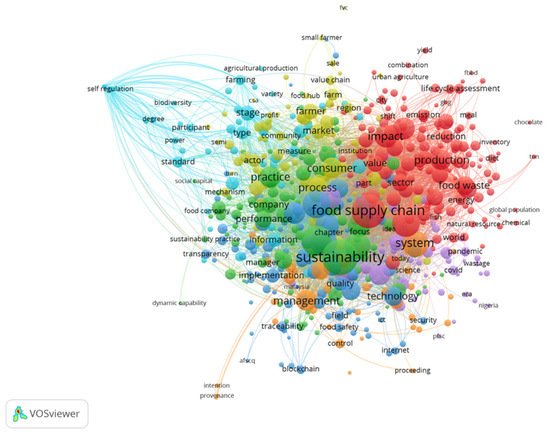
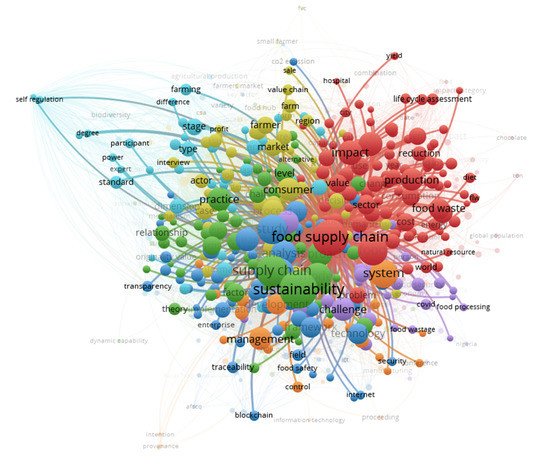

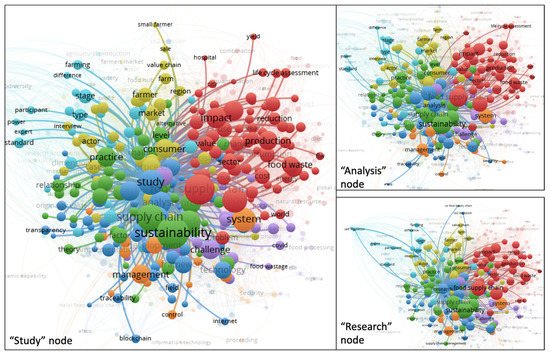
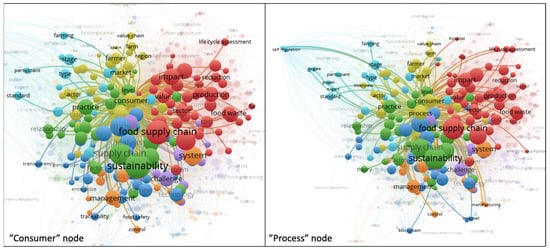
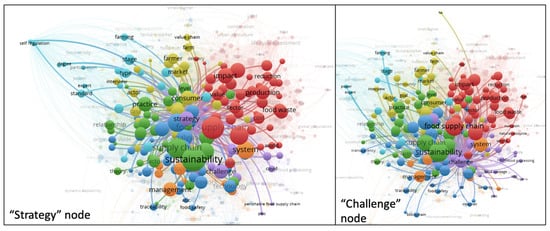
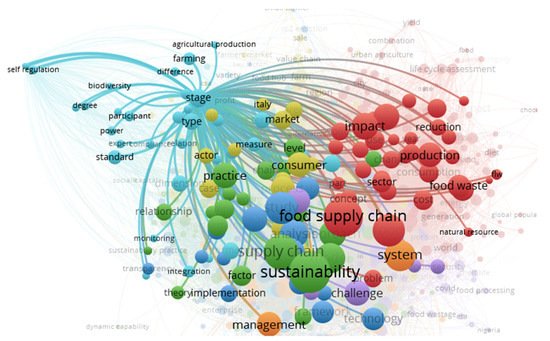

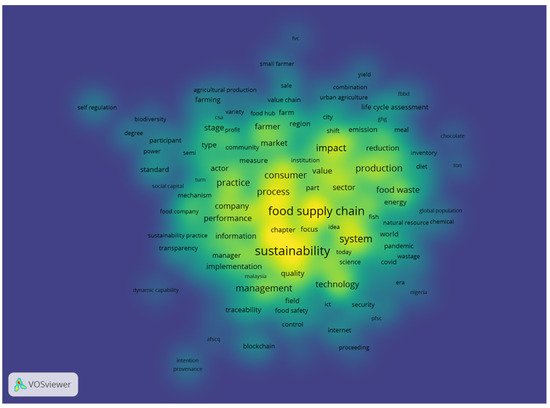
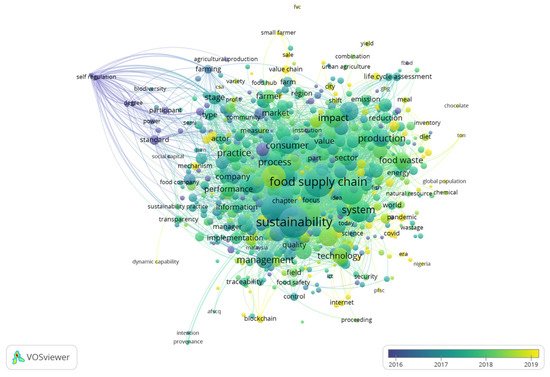
2. Results: Science Mapping Analysis
Science Mapping was performed through cluster analysis. The clustering process, concluded by VOSViewer software, supplies the thematic map of the research domains (food supply chain and sustainability). The present analysis provides a series of graphical maps (from Figure 6, Figure 7, Figure 8, Figure 9, Figure 10, Figure 11, Figure 12 and Figure 13) that represent the overall network of recurrent terms, and, in sequence, the zoom on the main node of each cluster. Specially, Figure 6 shows the resulting overall thematic map, characterized by a network of seven clusters, in which, a node corresponds to a recurring term. Each cluster is marked by a different color and ordered by numerosity of nodes: the first cluster (149 nodes) in red, the second (105 nodes) in green, the third (104 nodes) in blue, the fourth (84 nodes) in yellow, the fifth (52 nodes) in lilac, the sixth (48 nodes) in light blue and the seventh (35 nodes) in orange. This map arranges terms by occurrences and allows exploration, cluster by cluster, of the terms and interpretation of the related common themes. Specifically, the interpretation of common themes is conducted on the basis of the researchers’ knowledge and experience, that, fostered by the software capabilities, permits carefully obtaining results and finding answers to the research questions, as defined in the Methodology section [67]. Thus, in order to individuate (i) the main research routes in sustainable food supply chain, (ii) the main supply chain models studied in association with sustainability and (iii) the effort made by the academia in analysing the several sustainability dimensions, each cluster was analysed. Other considerations could be made leveraging the network density map and the overlay network map.

Figure 6. Thematic map resulting from VOSViewer clustering process.
2.1. Cluster Analysis
Cluster 1, the red one, is the biggest of the networks and encompasses 149 terms, captained by the “food supply chain” node, which is one of the research keywords. This node recurs 681 times in the data set and has 574 links within the network.
The “food supply chain” node, in combination with other similar nodes such as “entire food supply chain” and “global food supply chain”, guides the common theme of Cluster 1 that seems to collect terms linked to the food supply chain domain. Specifically, different elements of the supply chain and related concepts are mentioned: “delivery”, “cost”, “distribution”, “efficiency”, “effort”, “feasibility”, “food manufacturing”, “food production”, “food supply”, “food system”, “global supply chain”, “household”, “impact”, “impact category”, “increase”, “lifecycle”, “life cycle assessment”, “order”, “output”, “packaging”, “parameter”, “phase”, “place”, “plant”, “potential”, “processing”, ”raw material”, “resource”, “sector”, “shift”, “source”, “storage”, “supply”, “sustainable food system”, “transport”, “transportation”, “treatment” and “value”. Moreover, examining terms, it is possible to note that sustainability is addressed considering the environmental dimension, with particular attention to the evaluation of the impact that all phases of the entire food life cycle have on the environment, as attested by: “carbon emission”, “carbon footprint “, “emission”, “energy”, “energy consumption”, “environmental impact”, “environmental performance”, “environmental sustainability“, “food loss”, “food waste”, “greenhouse gas emission”, “ghg emission”, “impact”, “impact category”, “life cycle assessment”, “lca”, “natural resource”, “parameter”, “plate waste”, “reduction”, “sustainable food system”, “sustainable consumption”, “waste”, “waste reduction”, “water” and “water footprint”. It is interesting to note that Cluster 1, unlike the others, encompasses more terms determining specific food supply chains in terms of typology of food supplied: “animal”, “chocolate”, “fish”, “fruit”, “meat”, “vegetable” and “fresh produce”. This evidence leads researchers to assume that the evaluation of the environmental impact of food lifecycle within the supply chain is more investigated considering particular food product categories.
With reference to the “food supply chain” node, in addition to the internal links with other nodes of the same cluster, there are links to others clusters, which gives an input to interpret the association among different specific topics. Specifically, Figure 7 represents the main view of the “food supply chain” node and shows its linkages with terms of the cluster to which it belongs (e.g., “production”, “sector”, “impact”, “food waste”, “cost”, ”consumption”) and also with terms belonging to other clusters (e.g., “sustainability” and “practice” in the green cluster; “study” and “technology” in the blue cluster; “system” and “management” in the orange cluster; “consumer” and “market” in the yellow cluster; “standard” and “self regulation” in the light cluster; “challenge” and “strategy” in the lilac cluster).

Figure 7. “Food supply chain” node and its linkages.
Cluster 2, the green one, is composed of 105 terms guided by the “sustainability” node, which is one of the search keywords. This node recurs 738 times in the data set and results in 571 links within the network. Figure 8 represents the main view of the “sustainability” node and shows its linkages with terms of its own cluster (e.g., “practice”, “supply chain”, “relationship”) and also with the terms belonging to other clusters (e.g., “food supply chain”, “food waste” in the red cluster; “study”, “technology” in the blue cluster; “system”, “management”, in the orange cluster; “consumer”, “market” in the yellow cluster; “standard”, “farming” in the light cluster; “challenge”, “strategy” in the lilac cluster). This main node gives the common print of Cluster 2, which seems to collect terms linked to the sustainability domain. Particularly, the three sustainability dimensions are directly or indirectly mentioned: (i) the environmental one is represented, among others, by “environmental sustainability”, “environmental impact”, “environmental performance”, “carbon emission”, “carbon foot print” terms; (ii) the social one is represented, among others, by “social sustainability”, “social impact”, “corporate social responsibility” terms; finally, (iii) the economic one is represented, among others, by “economic sustainability”, “performance”, “success”, “sustainable business model” terms. No particular inclination to food domain is attested, in fact the second main node is “supply chain”, a general term linked to “industry” in general. The common theme of Cluster 2 arose from the analysis of recurring terms (e.g., “applicability”, “approach”, “assessment”, “attention”, “best practice”, “business”, “case study”, “company”, “constraint”, “criterium”, “decision maker”, “decision making”, “driver”, “key driver”, “governance”, “improvement”, “implication”, “investment”, “manager”, “policy maker”, “practice”, “progress”, “roadmap”, “sustainability assessment”, “sustainability indicator”, “sustainability performance”, “sustainability practices”, “sustainable business model”, “sustainable supply chain”, “sustainable supply chain management”) and is related to environmental, social and economic sustainability dimensions along the supply chain, and is, as well, regarded as key drivers for adoption of best practices in real business context.

Figure 8. “Sustainability” node and its linkages.
Cluster 3, the blue one, is composed of 104 terms. The main node is “study” (recurring 457 times and with 745 linkages) followed by “analysis” (recurring 342 time and with 566 linkages) and “research” (recurring 270 time and with 561 linkages) (Figure 9). These terms give, to Cluster 3, the print of empirical research. Specifically, the presence of nodes such as “technology”, “enabler”, “analysis”, “blockchain”, “blockchain technology”, “communication technology”, “conceptual framework”, “data collection”, “empirical research”, “ict”, “implementation”, “information sharing”, “internet”,“iot”, “origin”, “security”, “solution”, “traceability”, “traceability system”, “transparency”, “trust” and “quality” connotes the empirical research theme as oriented to technological solutions for agri-food system able to face traceability, transparency, security, trust and quality issues. Therefore, the application domain of Cluster 3 is the agri-food system, as attested by the following nodes: “agrifood supply chain”, “afsc”, “agrifood sector”, “food quality”, “food safety”, “food supply chain management”, “fresh food supply chain”, “fresh produce”, “fsc”, “halal food supply chain”, “sustainable agrifood supply chain” and “sustainable agriculture”. In summary, Cluster 3 seems to be oriented to empirical research or studies about technological solutions able to assure food quality and safety, traceability and to enhance trust.

Figure 9. “Study”, “analysis” and “research” nodes and their linkages.
Cluster 4, the yellow one, is composed of 84 items and shows the “consumer” (recurring 261 times and with 559 linkages) and “process” (recurring 236 times and with 558 linkages) nodes as main ones. These main nodes and the related links are represented in Figure 10. Investigating through the other nodes, several well-focused terms capture the research attention: “actor”, “advantage”, “agri food system”, “agri food supply chain”, “alternative food network”, “circular economy”, “community”, “consumer”, “cooperation”, “customer”, environmental benefit”, farm”, “farmer”, “farmers market”, “food chain”, “food hub”, “food producers”, “food sustainability”; “Italy”, “local food”, “local food supply chain”, “local food system”, “value chain”, “market”, “ profitability”, “sfsc”, “sfscs”, “short food supply chain”, “smaller farmer”, social benefit”, “social sustainability”, “spain”, “sustainable development” and “turkey”. The sustainability issue is considered from all of its three viewpoints. The agri-food sector, with particular focus on the short and local food supply chain models, results in the main domain. It is interesting to note the presence of nodes with country names, helpful to give a geographical context of the Cluster 4 common theme. In summary, this cluster encompasses terms linked to the short and local supply chain models capable of involving the consumers in the supply chain and enabling the environmental and social sustainability of small farmers. Specifically, the opportunity to encompass the consumer in the food lifecycle enables the transformation of the supply chain in a value chain.

Figure 10. “Consumer” and “process” nodes and its linkages.
Cluster 5, the lilac one, is composed of 52 items and the main nodes are “strategy” (recurring 270 times and with 548 linkages) and “challenge” (recurring 265 times and with 542 linkages) which characterize the common theme of Cluster 5 (Figure 11). This cluster demonstrates a focus on the challenges that the world is facing today and the related strategies. More clarity derives from the analysis of the others nodes, leading the researcher to individuate a specific focus of the common theme: “availability”, “challenge”, “competitiveness”, “covid”, “crisis”, “digital technology”, “disruption”, “economic sustainability”, “economy”, “food insecurity”, “health”, “infrastructure”, “logistic”, “need”, “organization”, “pandemic”, “perishable food supply chain”, “perishable product”, “risk”, “safety”, “shelf life”, “strategy” and “sustainable development”. Technology is also mentioned in this cluster, although it is not the principal focus, as happened in Cluster 3. Therefore, the common theme of Cluster 5 is the attention to the strategies, with a focus on technological solutions for facing current challenges and crises (economic, environmental and organizational in the perishable food supply chain) such as the pandemic condition caused by covid 19 global diffusion.

Figure 11. “Strategy” and “challenge” nodes and their linkages.
Cluster 6, the light blue one, is composed of 48 items with “stage” (recurring 133 times and with 505 linkages) as a main node. This main node, although it has a low level of occurrence in comparison with the main nodes of other clusters, is widely connected with other clusters, as Figure 12 shows. Analyzing the nodes of Cluster 6 (e.g., “account”, “agrobiodiversity”, “biodiversity”, “compliance”, “degree”, “difference”, “effectiveness”, “evaluation”, “expert”, “farming”, “food company”, “government”, “industry self regulation”, “integration”, ”measure”, “monitoring”, “regulation”, “reliability”, “self regulation” and “standard”), researchers individuate a clear connotation toward standards or regulations in the agri-food sector in association with environmental sustainability issues linked to agrobiodiversity. Therefore, the common theme of Cluster 6 results as the analysis of food supply chain compliance to regulations and standards with particular focus on farming stage and with the aim to safeguard agrobiodiversity.

Figure 12. “Stage” node and its linkages.
Cluster 7, the orange one, is composed of 35 items; although it is the most minor cluster in terms of nodes numerosity, it shows several big nodes, among which are “system” (recurring 450 times and with 557 linkages), “management” (recurring 256 times and with 546 linkages) and “development” (recurring 203 times and with 536 linkages). This last cluster seems to be oriented to the knowledge produced along the activities of investigation, education, management, application, planning, dissemination and development. This evidence emerges from terms analysis, such as: “application”, “attitude”, “building”, “conference”, “development”, “education”, “idea”, “investigation”, “knowledge”, “management”, “manufacturing”, “optimization”, “planning”, “questionnaire”, “science”, “simulation” and “university”. The domain is, in this case, not clearly interpretable.
As previously stated, Cluster 7 encompasses few nodes but has a large size. This evidence means that some terms are more recurrent within the data set and intercept other clusters through strong linkages. Figure 13 shows how “system”, “management” and “development” nodes are linked with other ones. Specially, “system” is connected to: (i) Cluster 1 with “food”, “food supply chain”, “product”, “production”, “value”, “environmental impact”, “food waste” and “policy”; (ii) Cluster 2 with “sustainability”, “supply chain”, “approach”, “model”, “practice” and “factor”; (iii) Cluster 3 with “paper”, “analysis”, “data”, “framework” and “technology”; (iv) Cluster 4 with “consumer” and “process”; Cluster 5 with “challenge”, “operation” and “strategy”; (v) Cluster 6 with “information”. The “management” node is connected to: (i) Cluster 1 with “food supply chain” and “product”; (ii) Cluster 2 with “sustainability”, “approach”, “model”, “practice” and “factor”; (iii) Cluster 3 with “study”, “research”, “literature”, “analysis”, “framework” and “data”; (iv) Cluster 4 with “process”; (v) Cluster 5 with “challenge”; (vi) Cluster 6 with “stage” and “self regulation”. The “development” node is connected to: (i) Cluster 1 with “food supply chain” and “food”; (ii) Cluster 2 with “sustainability”, “supply chain”, “approach” and “model”; (iii) Cluster 3 with “research”, “study”, “analysis” and “paper”.

Figure 13. “System”, “management” and “development” nodes and their linkages.
2.2. Density Visualization
The density visualization of the thematic map, in Figure 14, is a particular view of the network leveraging on density parameter. Specifically, the denser a specific zone of the network, the brighter and more yellow the zone. Figure 14 shows a major density of the network around the two search keywords “food supply chain” and “sustainability”. This result is not surprising because, due to the setting of the search scheme, these keywords compare in the title, abstract and/or keywords of the data set. The terms that are strictly satelliting around these two nodes are more linked with them, meaning that they are frequently found together within a manuscript. These terms are “process”, “consumer”, “system”, “impact”, “management”, “technology”, “company”, “performance”, “practice”, “production”, “information” and “quality”.

Figure 14. Density visualization of the thematic map.
2.3. Overlay Visualization
The overlay visualization shows the evolution of terms comparing over time (Figure 15). This result gives a part of knowledge about the actuality of themes that are represented in this map in yellow color. For example, blockchain results as one of the more recent concepts within the network, and this result is confirmed by the fact that the blockchain is one of technology deriving from the Industry 4.0 paradigm. It is front line in more industrial sectors, including the agri-food one. Another piece of evidence is the “covid” and “pandemic” location: obviously nowadays. However, the main nodes of the network, which corresponding to the chosen search keywords, appeared within the dataset since the 2017. Otherwise, Cluster 6 encompasses terms related to regulation and standard topic, resulting in the oldest ones.

Figure 15. Overlay visualization of the thematic map.
This entry is adapted from the peer-reviewed paper 10.3390/su132111816
This entry is offline, you can click here to edit this entry!
